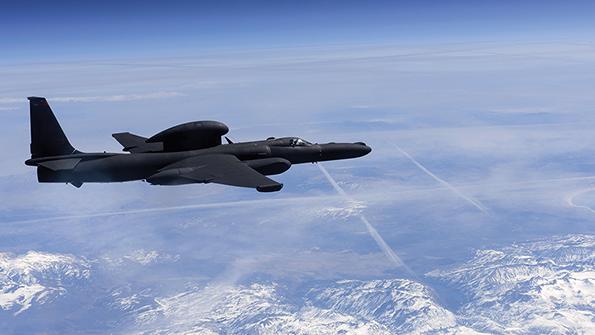
Three Lockheed Martin aircraft—the U-2S, F-22 and F-35A—quietly are demonstrating a new way of American warfare, in which stealth jets team up with the venerable high-altitude platform to replace spy satellites and traditional airborne command posts.
- F-35 sensors cued PAC-3 interceptor battery
- U-2S enabled bidirectional comms between F-35 and F-22
An eight-year series of demonstrations led by Lockheed’s Skunk Works has culminated in the newly completed Project Hydra, which showed how to overcome design decisions that prevented these aircraft from being able to share data among one other or critical weapon systems on the ground.
In the process, the demonstration, which also was supported by the Missile Defense Agency and Air Force, additionally highlighted an emerging style of warfare. If the day comes that access to spy satellites can be negated and sensor-carrying command centers—such as Boeing E-3 AWACS and Northrop Grumman E-8C Joint Stars—are chased off the battlefield map, the new airborne sensor and communications network demonstrated by Project Hydra may play an essential role with a wide variety of current and future aircraft.
“Project Hydra marks the first time that bidirectional communications were established between fifth-generation aircraft in flight while also sharing operational and sensor data down to ground operators for real-time capability,” says Jeff Babione, Skunk Works vice president and general manager.
Specifically, an F-22 transmitted data on the Intra-Flight Data Link (IFDL) to an Open Systems Gateway (OSG) payload onboard the U-2. The OSG, supported by the U-2’s Enterprise Mission Computer 2 system, then instantly created a network not unlike the many-headed Hydra serpent of Greek mythology, facilitating overlapping data streams among the F-22’s IFDL and the Multifunction Advanced Data Link (MADL) on five F-35s, as well as to multiple ground systems.
As the F-22 collaborated with its fifth-generation fighter wingmen, the F-35 passed its own sensor data over the MADL to an airborne gateway. It then delivered the messages via a Tactical Targeting Network Terminal (TTNT) link to the Army’s Integrated Air and Missile Defense Battle Command System (IBCS) via a newly developed Lockheed Airborne Sensor Adaptation Kit (A-Kit). The company previously delivered F-35 sensor data to a MADL Ground Station called Harvest Lightning. The A-Kit allows the F-35 to deliver the missile tracking data to the IBCS through Harvest Lightning, or directly via a TTNT message.
The capability means the IBCS can feed missile tracks to a Patriot Advanced Capability-3 battery using the stealthy F-35’s over-the-horizon field of view instead of relying only on ground-based tracking radars.
Finally, by connecting via the U-2, the F-35 and F-22 can remain in contact through Link 16 and beyond-line-of-sight links to the ground-based alternatives to the E-3G and E-8C: the newly opened Common Mission Control Center at Beale AFB, California; and the Shadow Operations Center at Nellis AFB, Nevada.
In a single demonstration, Project Hydra satisfied several of the common objectives of the Air Force’s Advanced Battle Management System and the Army’s Project Convergence with the creation of a resilient, multidomain network.
“This next-level connectivity reduces the data-to-decision timeline from minutes to seconds, which is critical in fighting today’s adversaries and advanced threats,” Babione says.
Project Hydra builds on nearly a decade of Lockheed-directed demonstrations of airborne networking capabilities involving the F-35A, F-22 and U-2S. In 2013, Project Missouri showed how an F-22 could pass data over the secure Chameleon waveform to the F-35 avionics testbed in flight by repurposing L-Band antennas already on the jets as air combat maneuvering instrumentation.
Four years later, Project Hunter demonstrated another breakthrough in airborne networking with an F-22A able to retarget a Lockheed AGM-158C Long-Range Anti-Ship Missile, fired by a Navy fighter, via an ad hoc airborne mesh network established by a U-2S.
Each demonstration supports a vision of future warfare that demands seamless data transfers among air, ground and surface systems that were not designed to collaborate with each other. In some cases, these secure, ad hoc mesh networks must be assembled literally on the fly, patching together disparate radios for the first time in flight. To enable that capability, Lockheed showed in a demonstration last November that the software for the U-2S mission computer could be updated in flight using a ground-based transmission and software code containerized by Google’s Kubernetes orchestration tool.






Comments